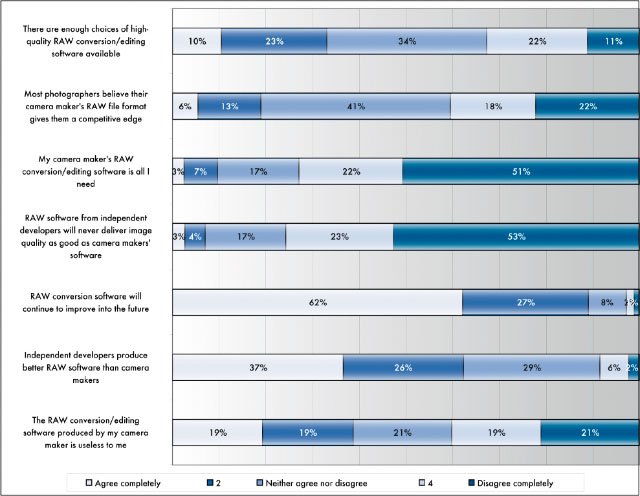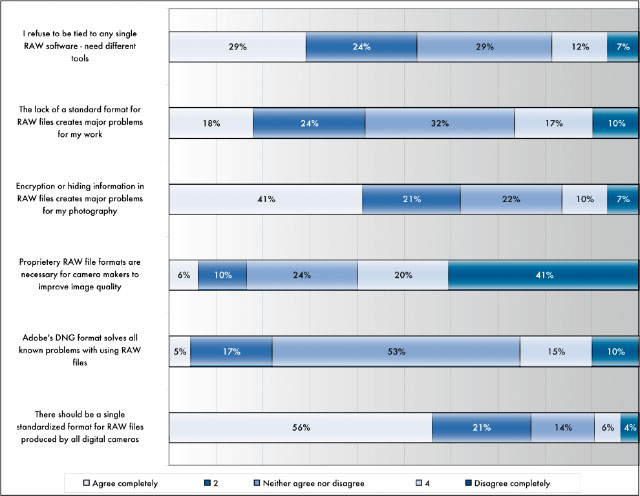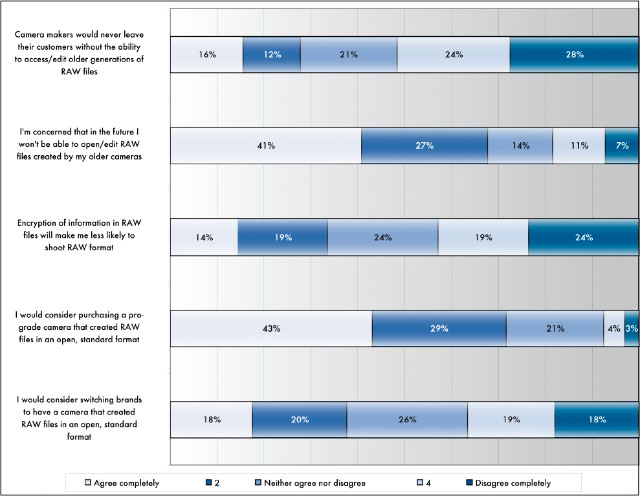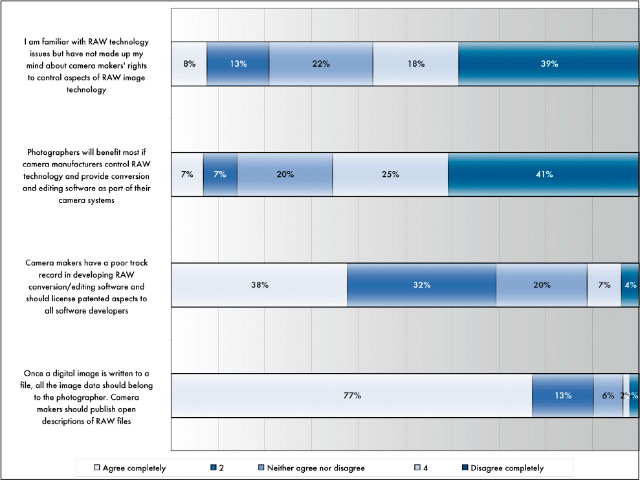The 2006 RAW Survey - Chapter 4
Chapter 4. Respondents’ Experiences, Beliefs, and Preferences Concerning RAW Imaging Technology
Question #10 of the 2006 RAW Survey asked respondents to use a five-point scale (ranging from "1 = Agree completely" through "3 = Neither agree nor disagree," to "5 = Disagree completely") to indicate the extent to which they agreed or disagreed with a series of 18 statements about various aspects of RAW imaging technology. The statements focused on three broad topics: RAW conversion/editing software, RAW file conversion/editing workflow, and possible future decisions or choices related to RAW technology. Response distributions to these items are presented in Charts 17, 18, and 19 below. The text of the statements to the left of the bar charts is a shortened version of the actual questionnaire wording.
Chart 17. Percentage of Respondents That Agree or Disagree
with Seven Statements about RAW Conversion/Editing Software
Respondents were evenly divided in their views on the statement, "There are enough choices of high-quality RAW conversion or editing software available." Exactly one-third of respondents expressed both agreement (33%) and disagreement (33%), and 34% neither agreed nor disagreed. Nearly identical percentages indicated that they "agree completely" (10%) and "disagree completely" (11%).
About twice as many respondents disagreed (40%) than agreed (19%) with the statement, "Most photographers believe that their camera makers’ proprietary RAW file format gives them a competitive edge." However, a slightly larger proportion (41%) expressed neither agreement nor disagreement with the statement. The overall balance of responses clearly indicates that relatively few respondents believe that most photographers look to their camera makers for the software that will help them to be more competitive.
The next two statements displayed in Chart 17 ("My camera maker’s RAW conversion or editing software is all I need for my photography," and "RAW conversion or editing software produced by independent developers will never deliver image quality as good as the camera makers’ own software") received similar response patterns. About three-fourths of respondents (73% and 76%) disagreed with both statements, and over half (51% and 53%) indicated that they "disagree completely." Only small minorities of respondents agreed with either statement (10% and 7%) with only 3% indicating they "agree completely." Only one-sixth of respondents (17%) expressed neither agreement nor disagreement with both statements.
Nearly 9 in 10 respondents (89%) agreed that "RAW conversion software will continue to improve into the future," with 62% indicating they "agree completely." Only 8% of respondents expressed neither agreement nor disagreement, and a total of 3% expressed any level of disagreement. This statement drew greater percentages of overall agreement (and "complete agreement") than any other in this series of items and stands in stark contrast to the even division of perceptions on the first statement described above concerning whether there were "enough choices of high-quality RAW conversion/editing software available."
More than three-fifths of respondents (63%) agreed – with nearly two-fifths (37%) agreeing completely – that "independent developers produce better RAW software than camera manufacturers." Only 8% of respondents disagreed with this statement, while nearly 3 in 10 (29%) neither agreed nor disagreed. These results are consistent with those presented in Charts 14, 15, and 16, in which only a minority of respondents expressed the view that software from camera makers provided either the best image quality or the best workflow.
Respondents were very evenly divided in their reactions to the statement, "the RAW conversion or editing software produced by my camera maker is useless to me" – about one-fifth of the respondents chose each of the five response options. That nearly 40% of respondents agreed with this statement suggests that camera manufacturers have not succeeded in convincing a large proportion of their customers that their own software provides significant advantages in the conversion or editing of the RAW that files their cameras create. At the same time, an equal percentage of respondents disagreed (and 19% disagreed "completely") that the camera makers’ software is "useless." Camera makers have a significant customer base for their software. But as we will see further below, these customers have strong views about whether proprietary RAW file formats contributes to the value of software produced by camera companies.
Chart 18 below presents response distributions in the same format for questionnaire items that focus on six statements about RAW processing workflow issues, including both the performance of RAW conversion/editing software as well as the impact of file formats on RAW image processing.
The majority of respondents (53%) agreed with the statement, "I refuse to be tied to any single RAW conversion or editing software product; I need different tools for different assignments or clients;" nearly 3 in 10 respondents indicated that they "agree completely." In contrast, nearly one-fifth (19%) disagreed, although only 7% reported they "disagree completely." Twenty-nine percent neither agreed nor disagreed. These responses confirm that the majority of respondents do not believe that any single RAW conversion or editing software product meets all of their needs – whether or not it was produced by a camera maker or an independent developer.
Respondents’ views were somewhat more divided on the statement, "the lack of a standard format for RAW files creates major problems in my work." Still, 42% of respondents agreed with the statement (including 18% that agreed "completely") compared to only 27% that disagreed (with 10% who disagreed "completely"). In this case, nearly one-third of respondents neither agreed nor disagreed, indicating that many respondents have not yet made up their minds about the advantages and disadvantages of a standard RAW file format.
In contrast to the previous item, a substantial majority of respondents (62%) agreed with the statement, "Encryption, hiding, or otherwise attempting to make any information in RAW files unavailable for use by other RAW software creates major problems for my photography." Only 17% disagreed with this statement (7% "disagree completely") and 22% neither agreed nor disagreed. Despite the explanations provided by camera manufacturers for the encryption of some RAW file parameters, most respondents apparently believe the disadvantages of this practice outweigh any potential advantages.
When presented with a statement expressing the opposite perspective, "Proprietary RAW file formats are necessary for camera makers to improve image quality," the response distributions almost exactly mirror the previous item – 61% of respondents disagree (41% "disagree completely") and only 16% agree (6% "agree completely"), with nearly one-quarter (24%) neither agreeing nor disagreeing. Substantial majorities of respondents do not agree that proprietary RAW file formats are "necessary" for image quality to improve.
Chart 18. Percentage of Respondents That Agree or Disagree
with Six Statements about RAW Conversion/Editing Workflow
An unusual response pattern is apparent for the next statement, "Adobe’s Digital Negative (DNG) format solves all known problems with use of RAW files." Those who express agreement (22%) and disagreement (25%) with the statement are roughly equally divided – with most of both sides holding relatively milder degrees of agreement/disagreement. However, the majority of respondents (53%) indicated that they "neither agree nor disagree." The DNG format appears to have generated only modest rates of either acceptance or rejection in the marketplace, with most respondents holding a more neutral stance.
Finally, in response to the statement, "There should be a single standardized format for RAW files produced by all digital cameras," over three-fourths (77%) of respondents expressed agreement, with over half (56%) agreeing "completely." In this case, only 10% of respondents disagreed (4% "disagree completely"), and only 14% neither agreed nor disagreed. When these results are compared to those for the statement on the relationship of proprietary RAW formats to image quality improvement (two statements above), respondents agree much more about their preference for a standardized RAW format than they agree about whether proprietary RAW formats are necessary for improved image quality.
Chart 19 displays response distributions for five statements that are more future-oriented, either with respect to expectations about the likely behavior of camera makers, software capabilities, or their own decisions concerning future investments in camera equipment.
Over half of the survey respondents (52%) disagreed with the statement that "camera makers would never leave their customers without the ability to access or edit their older generations of RAW files," including 28% who "disagree completely." Less than 3 in 10 respondents (28%) agreed, with only 16% agreeing "completely." About one-fifth of respondents (21%) neither agreed nor disagreed. It seems likely that these results are driven in large measure by the fact that some camera companies with proprietary RAW file formats have already abandoned camera production, raising the risk of "orphaned formats."
Even stronger opinions were expressed toward a similar statement with somewhat opposite content, "I am concerned that in the future I won’t be able to open or edit RAW files created by my older digital cameras." In this case, over two-thirds of respondents (68%) agreed with the statement (41% "agree completely"), while only 18% disagreed (7% "disagree completely").
These two items together reveal serious concerns that the ever-increasing proliferation of proprietary RAW file formats from each new camera model is putting respondents’ RAW image assets at considerable risk – a level of risk that creates significant discomfort among users of professional grade digital cameras.
Chart 19. Percentage of Respondents That Agree or Disagree with Five Statements
about Future Perspectives, Concerns, or Decisions Concerning RAW Technology
There was a more even distribution of responses to the statement, "Encryption of information in RAW files will make me less likely to shoot in RAW format." Over two-fifths (43%) disagreed with this statement (24% disagreed "completely"), while one-third (33%) agreed (14% "completely"). Nearly one-quarter of respondents (24%) neither agreed nor disagreed. This distribution is not easy to interpret. On the one hand, encryption of one type of data in RAW files produced by one camera maker (Nikon’s encryption of "as shot" White Balance coefficients) directly affects only those respondents who own and use affected camera bodies. Thus, most respondents were answering this question "theoretically;" they had not experienced any disruptive impact of encryption of data in RAW files. On the other hand, respondents who reported that they used Nikon cameras "most often," had among the highest percentages that disagreed, and the lowest that agreed with the statement – suggesting that most respondents who might have been directly affected did not find the impact to be very difficult to work around.
Despite the previous result, nearly three-fourths of respondents (72%) agreed with the statement, "I would consider purchasing a professional grade camera that created RAW files in an open, standard format." More than two-fifths (43%) agreed "completely" with the statement. In comparison, only 7% disagreed (only 3% disagreed "completely"), and only one-fifth (21%) neither agreed nor disagreed. Among our respondents, there is clear interest in the option of a professional grade digital camera that will produce RAW files in a more open, standardized format.
In comparison, about 2 in 5 respondents (38%) agreed with the final statement in this sequence, "I would consider switching brands to have a camera that created RAW files in an open, standard format." This total included 18% who agreed "completely." An equal percentage (37%) disagreed (also with 18% who disagreed "completely"), while about one-quarter (26%) neither agreed nor disagreed.
Table 7 below shows the total percentages for a cross-tabulation of responses to the last two statements. The first row shows that of the 72% of respondents that indicated they would consider purchasing a camera that would produce RAW files in an open, standardized format, 34% (nearly half of the 72%) would consider switching brands to do so. That is, over one-third of all survey respondents (34% - over 6,400 respondents) reported that they would consider purchasing a professional grade camera that produced RAW files in an open, standardized format and would consider switching camera brands to gain that feature.
Table 7. Relationship between Willingness to Consider Purchasing a Professional Grade
Camera that Produces RAW Files in an Open, Standard Format and
Willingness To Switch Camera Brands To Make such a Purchase
| Would consider switching brands to purchase a camera that produced standard RAW files | ||||
|---|---|---|---|---|
| Would consider purchasing camera that produced standard RAW files |
Agree | Neither agree nor disagree | Disagree | Total |
| Agree | 34% | 18% | 20% | 72% |
| Neither agree nor disagree | 3% | 7% | 11% | 21% |
| Disagree | -- | 1% | 6% | 7% |
| Total | 37% | 26% | 37% | 100% |
It is difficult to over-state the potential importance of this result. There are very few features that camera manufacturers could focus on that would be as likely to affect the future purchasing decisions of customers as the decision to market a professional grade camera that would produce RAW files in an open, standardized format.
Perspectives on Overall RAW Imaging Technology
Survey Question #15 also asked respondents to express their level of agreement or disagreement using the same five-point scale with four general statements about their orientation toward the most general issues related to RAW imaging technology. Response distributions are shown in Chart 20 below.
As shown in the top bar of Chart 20, survey respondents generally feel they are informed and have made up their minds concerning issues related to "whether camera makers’ have any rights to keep any parts of a RAW image file secret." Fifty-seven percent disagreed (39% disagreed "completely") with the statement, "I am familiar with the RAW technology issues, but I have not made up my mind" about whether camera makers have any such rights. Only 21% agreed with the statement (8% agreed "completely") and another 22% neither agreed nor disagreed.
Chart 20. Percentage That Agree or Disagree with Four Statements about RAW Imaging Technology Issues
The next statement, "Photographers will benefit most if camera manufacturers control RAW technology and provide conversion and editing software as part of their camera systems," was met with even more disagreement. A total of two-thirds (67%) of respondents disagreed, and 41% disagreed "completely." Only 14% agreed with this statement (7% agreed "completely"), and one-fifth neither agreed nor disagreed. Despite years of efforts to persuade their customers that proprietary RAW imaging technology are beneficial aspects of a "total imaging system," most survey respondents rejected that concept.
Reinforcing this view, about 70% of respondents agreed (38% agreed "completely") with the statement, "Camera makers have a poor track record in developing RAW conversion and editing software that meets photographers’ needs. They should license patented aspects of their RAW technology to all software developers for reasonable fees." Only 11% disagreed with the statement (4% "completely") and 20% neither agreed nor disagreed. Overwhelmingly, respondents to the 2006 RAW Survey do not have confidence that camera makers can or will provide software solutions at the same caliber as their camera hardware.
Finally, 90% of respondents agreed (77% agreed "completely") that "once a digital image is written to a file by a camera, data in all parts of the image file should belong to the photographer who captured the image. Camera makers should publish full and open descriptions of all parts of the RAW image files their camera produce." Only 4% of respondents disagreed with this statement, and only 6% neither agreed nor disagreed. Respondents clearly had exceptionally strong opinions on this matter. Camera makers that do not recognize and take account of these perceptions are at risk that their customers may decide to make future equipment purchases from camera makers that share their views and values concerning the information stored in RAW image files.



